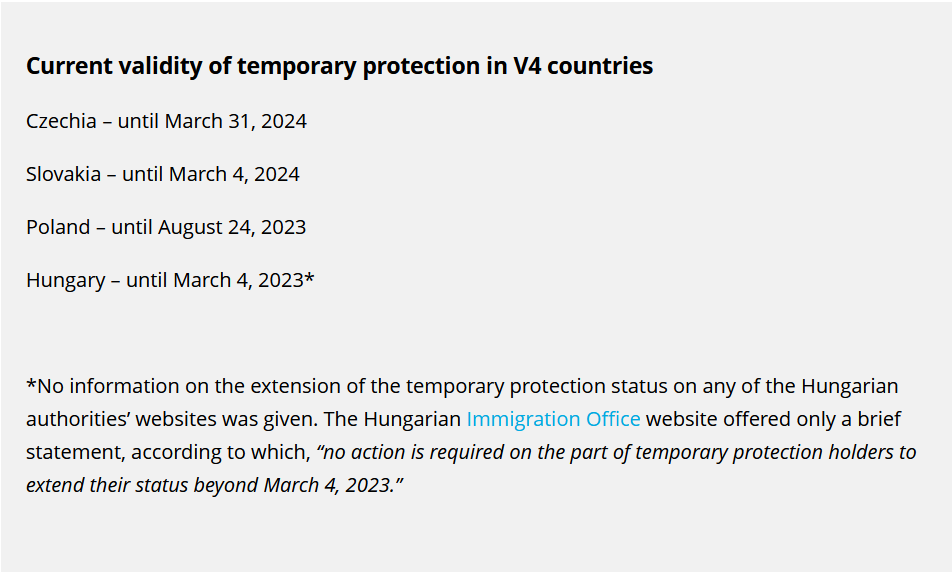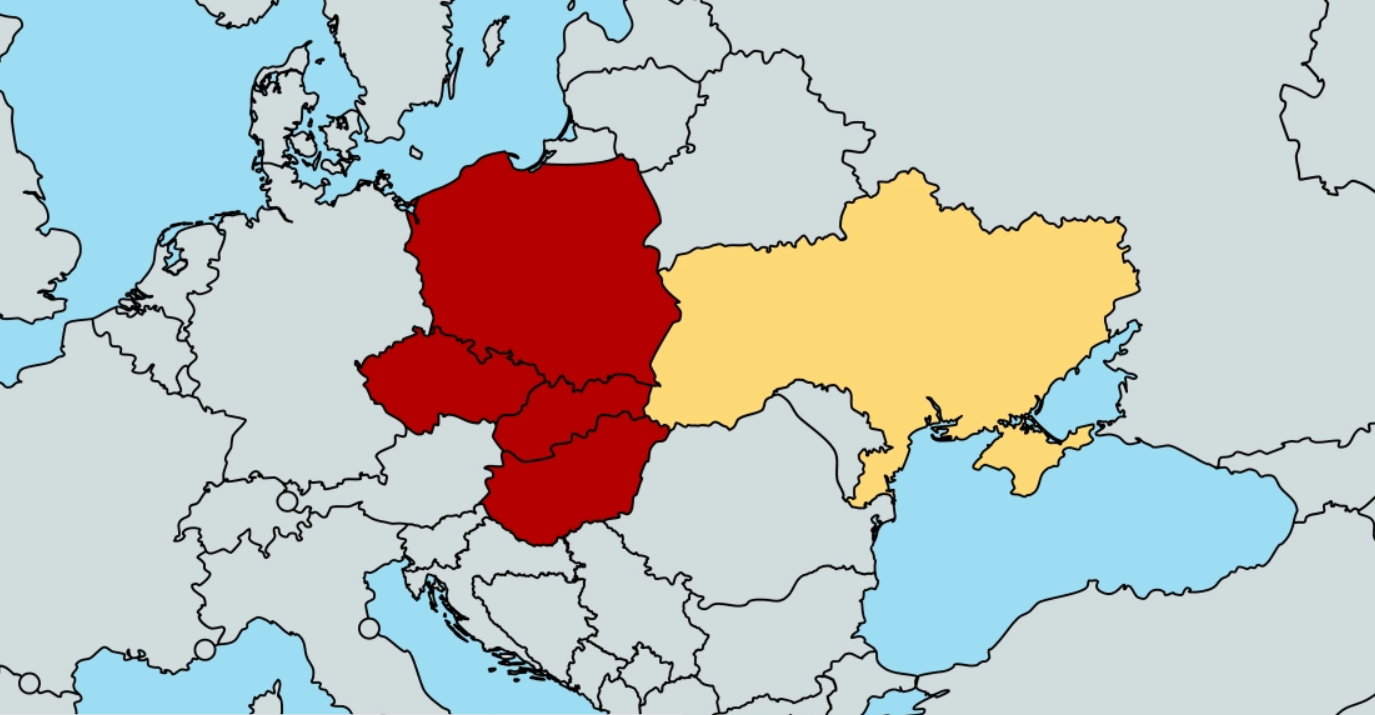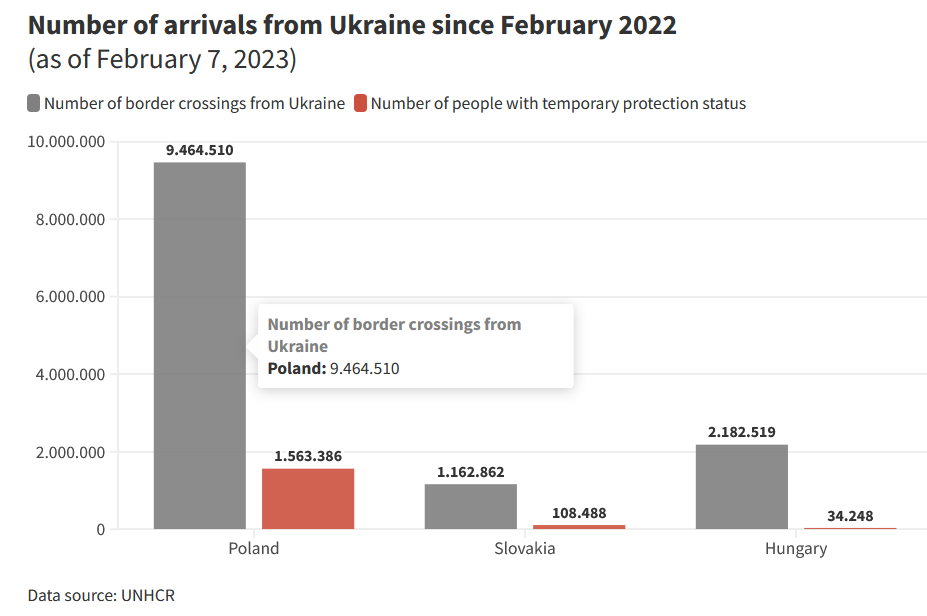Over 12 million – that's the number of people who've left Ukraine for a neighbouring nation, often one of the Visegrad Four (V4), over the past year. After a brief stop in Poland, Hungary, or Slovakia, most refugees continued further west, but the number of those who stayed was still relatively high, especially compared to the local average. Even those who eventually continue westward needed essential assistance during the first hours or days or their stay, be it food, water, healthcare, basic shelter or transportation. Managing the beginning of the refugee crisis in all recipient countries took immense effort and cooperation among governmental structures, non-profit sectors, and volunteers.
How did Poland, Hungary and Slovakia differ in their reactions to the influx of refugees during the first few days and weeks of the war? Is the official data regarding the number of refugees even reliable? And what challenges await central Europe as it continues its attempts to integrate the newcomers? These are just some of the questions we have discussed with five experts who possess both theoretical, as well as first-hand experience, relating to the topic of forced migration.
Our experts included:
Anna Dolińska from the
Institute of Public Affairs (IPA) in Warsaw who evaluated the developments in Poland;
Béla Soltész, a migration expert from the faculty of
Social Sciences at Eötvös Loránd University in Budapes - who also worked with the NGO Menedék until quite recently - contributed information from a Hungarian point of view; and three specialists from People in Need Slovakia
- Andrea Najvirtová, PIN Slovakia's Director,
Lenka Zápotocká, Head of the Department of Social Integration Programs, and
Romana Sládeková, a Monitoring and Evaluation (M&E) Officer - shed light on the situation in Slovakia.
The Visegrad Four (V4) countries (Author: Migration Awareness Department)
Poland: a swift government reaction and a determined society
The Polish-Ukrainian border is over 500 kilometres long, and has six crossing points. The mass arrival of refugees was hardly a surprise when Russian aggression transformed into open war, says Dolińska. Reception centres were quickly built along the border, providing basic emergency aid to refugees, from food and clothes to children’s toys. From there, people could go directly to refugee camps, where they were provided with more advanced types of assistance.
The Polish-Ukrainian border is over 500 kilometres long, and has six crossing points. The mass arrival of refugees was hardly a surprise when Russian aggression transformed into open war, says Dolińska. Reception centres were quickly built along the border, providing basic emergency aid to refugees, from food and clothes to children’s toys. From there, people could go directly to refugee camps, where they were provided with more advanced types of assistance.
The arrival of refugees from Ukraine has mobilised Polish society in an unprecedented way.
The question of how Ukrainian refugees could receive any sort of status and what benefits they were entitled to was resolved almost immediately. A new special law assisting forcefully displaced Ukrainian citizens went from draft form to taking full effect in a mere 16 days. Thanks to this legal arrangement, Ukrainian refugees had access to the same basic necessities as ordinary Polish citizens, as far as access to healthcare, education, or employment went. This temporary protection status was granted for 18 months.
For some time, Ukrainian refugees were even able to ride public trains on Polish territory for free, and many local governments also allowed free access to public transportation the their respective region.
The arrival of Ukrainian refugees has mobilised Polish society in an unprecedented way. As Dolińska states, our society’s reaction vastly exceeded all our expectations. According to her, a mass social movement of volunteers who travelled to the borders, reception centres, and train stations materialised. People would invite the Ukrainian people to their homes, give them money, and offer transportation.
A new non-profit sector quickly sprung into existence.
According to research conducted at the time, public support was just shy of 100% at the beginning of the crisis, and while this number has dropped since then, the dip was much smaller than some experts predicted. According to the latest data, about 80% of Polish citizens still want to continue aiding Ukraine and its people.
The Double Standard
The open arms with which Poles welcomed Ukrainians fleeing Russian aggression unfortunately only depicts only one side of Polish policy towards refugees. Our current government's response was good, but it was an exception, not the norm. Unfortunately.- says Dolińska. She points out that while the state offers a helping hand to Ukrainians, a little further north on the border with Belarus, it leaves other refugees literally dying in the woods, committing illegal push-backs and prosecutes volunteers who try to provide humanitarian aid to these refugees.
Hungary and Slovakia did come around, albeit a bit later
A quick and decisive response to the mass arrival of Ukrainian refugees was taken by the Hungarian government, too. The intent to grant refugees temporary 1-year protection was announced as early as the first day of the invasion, February 24th. As Soltész points out, this was in obvious contrast to the anti-immigration agenda that the Hungarian government had pursued in 2015.
And it was precisely this long-standing anti-immigration stance that Orbán’s administration had taken previously that left Hungary almost completely lacking in the face of this new mass wave of refugees.
During the past few years, nearly all reception facilities were closed and our integration mechanisms were all but dismantled, Soltész points out. As a result, most material aid rendered at border crossings and major train stations was provided by non-governmental and religious organisations.
However, governmental aid did come eventually. A large sports hall in Budapest was turned into the refugee reception central hub and religious organisations, as well as the Red Cross received a financial boost for helping out. Emergency shelters started to be operated by the government.
By the end of the second month of the war, the cooperation between religious organisations, the non-governmental sector, as well as several other local and foreign actors was relatively stable, Soltész concludes. This cooperation, according to him, is still in place to this day.
In Slovakia, the crisis ultimately helped improve the relationship between the civic sector and the government.
At the beginning of the crisis, measures in Slovakia followed a similar sequence. In the first few days following the invasion volunteers, as well as NGOs and local governments, were the driving force behind the assistance provided. Together, they supplied tents and toilets, distributed blankets, tea, food, provided psychosocial support, and coordinated accommodation.
At that time, cooperation with the government was rather informal, Najvirtová says. Still, day by day, the organisation and coordination of assistance from the state improved. Large-scale reception centres, a system of transportation and accommodation, and coordination were slowly established. As the government gradually took over the coordination of aid, NGOs were able to focus their activities both on specific regions and directly on Ukraine.
According to Najvirtová, the crisis ultimately helped improve the relationship between the civic sector and the government. A tangible outcome of this rapprochement subsequently became a memorandum between 11 non-profits and the Ministry of the Interior on the cooperation and joint planning in the event of a deterioration of the refugee situation.
What about the number of refugees? These days, only Poland keeps track
The five experts differ in their opinions about whether official calculations can be trusted. According to Dolińska, the number of people who have found temporary accommodation in Poland roughly corresponds to the statistics provided by the United Nations High Commissioner for Refugees (UNHCR). The number of Ukrainian refugees in Poland can be deduced from the system that assigns national identification number (known by the acronym PESEL in Polish).
UNHCR experts point to the data from PIN Slovakia as guidelines for planning their assistance activities in Slovakia since there is no Slovak alternative to the Polish PESEL identification system.
According to Soltész, Hungary's statistics on arrivals from Ukraine are complicated by the fact that not all refugees seek temporary protection. Thousands of people who have fled the war are staying in the country on work visas, tourist visas (meaning that they don't actually need a visa, but are limited to 90-day stay), or as dual citizens. Soltész estimates that the number of actual refugees (those staying regardless of what status they have) is somewhere between 50 and 100 thousand. In other words, the real figure might be one and a half to three times the official one.
The magnetic force of cities (and border areas)
The distribution of refugees within the destination countries is hardly surprising. Most of the arrivals eventually seem to congregate in capital cities or major towns, as they tend to offer much better opportunities for employment, education, and various types of social support compared to what's available in smaller towns and villages in the countryside.
One of the typical phenomena accompanying forced displacement around the world is a refugees’ desire to remain physically close to their homeland. So, does this also apply in the case of Ukraine? Judging by the situation in the countries that we have studied, sort of. But only in two out of three countries.
According to experts from PIN Slovakia, a greater concentration of refugees near the Ukrainian border is clearly visible. If they have a place to stay and enough to live off of, they prefer to stay in the east just so they can stay in contact with their families, even if the wages are lower than elsewhere, Zápotocká confirms.
A more pronounced concentration of refugees in the eastern part of the country (with the important exception of the capital) is also evident in the case of Hungary. In this context, Soltész mentions that the tendency of people with dual Hungarian-Ukrainian citizenship to "migrate" across the common border is particularly strong. Many of them have relatives in the neighbouring Transcarpathian region and even own property there already.
In Poland, on the other hand, the distribution of refugees is more or less even. For Ukrainians settling in Polish cities, Dolińska said, distance from the Ukrainian border does not play a major role. You can find them in cities located in the east and southeast, in cities such as Warsaw, Lublin or Rzeszów, as well as cities in the north and northwest like Gdańsk and Szczecin. It really varies.
On the issue of shuttle cross-border migration, Dolińska points out that special legal restrictions dampen this phenomenon in Poland – temporary protection holders who spend more than 30 days on Ukrainian territory lose their legal status in Poland. To the author's knowledge, no other similar restriction exists in any of the other V4 countries.
Detailed qualitative data is missing everywhere
The governments don’t collect detailed qualitative data in any of the countries discussed. The only publicly available information is on the number of border crossings and the number of temporary protection visas granted. Research that would collect and evaluate data on the social and demographic characteristics of the refugee population – and which could, as a result, significantly help this population to adapt better and/or integrate more effectively – continues to be responsibility of analysts from non-profit organisations and academia.
The lack of reliable and detailed data is, from many NGOs' points of view, one of the factors that hinder their work in terms of facilitating refugee integration. For instance, Romana Sládeková from PIN Slovakia views the large lack of qualitative data as major obstacle when it comes to arranging effective social support and other services for the refugees, and in terms of accommodating children who remain partially or fully connected to the Ukrainian education system through online education.
The biggest challenges are material needs, psychological care, and language training
What about the challenges in the field of refugee adaptation? Generally speaking, the problems that Poland, Hungary and Slovakia are facing with refugee integration are largely identical to those found in Czechia.
In Poland’s case, Dolińska highlights the potentially precarious situation of those who, for a variety of reasons ranging from old age to poor health, remain dependent on state-funded forms of collective accommodation. The recently approved amendment to the law on refugee assistance assumes, among other things, that people using this type of accommodation will contribute financially to its operation (progressively, based on the time since their arrival in the country). As a result, Dolińska argues, the most vulnerable refugees are at risk of finding themselves homeless.
Another major problem is in the area of psychological care provided to adolescents who continue to be deprived of education and find themselves isolated from their peers. Another notably difficult situation is that of mothers with small children, who struggle to combine work and childcare due to the chronically insufficient capacity of kindergartens.
Both our Slovak and Hungarian experts see a series of issues and challenges in the area of education. Among the urgent needs of the education system in Slovakia, Zápotocká mentions that better teacher preparation, improving the safety at schools, streamlining the curriculum and resolving the issue of entrance exams is needed.
In the case of Hungary, Soltész highlights the issue of additional language tuition. Only a few NGOs and volunteers offer Hungarian language courses. We need a general guideline in the area of language training and individual mentoring, which should be created and funded by the government. Teachers, Soltész says, need to be offered adequate financial incentives for the additional work associated with working with Ukrainian pupils, given the chronic underfunding of Hungarian education.
Dolińska also mentions that accommodation is a major problem. The difficult financial and material situation of the refugees appears in different forms in both Slovakia and Hungary. The question is, how many people will be able to afford commercial rents once the housing support ends and we switch over to the system of standard social benefits, Zápotocká says on the future developments in Slovakia. The living standards of Ukrainian refugees are in danger of falling below the poverty line.
A concern that surfaces in one form or another in all the assessments relates to the question of how sustainable the current aid and support targeted at Ukrainians refugees is in the face of economic difficulty and general fatigue.
Soltész has no qualms about bringing up the dismal amount of financial support that Ukrainian refugees in Hungary are entitled to. At present, adults only receive roughly €60 per person per month and children receive €30/month. This is not nearly enough, even if we take into account subsidised housing, free education, healthcare and transport. He believes that that the support should be at least three times as much.
Soltész identifies the regulation of the legal status of Ukrainian refugees as another topic that will need to be addressed soon. The temporary protection mechanism in Hungary was initially activated for one year, with the understanding that if the war continues, the protection will be extended. However, right now there seems to be no end in sight to the conflict. Moreover, as Soltész points out, even if the war were to end today, a large number of Ukrainian people will not be able to return home, if only because of the extent of the devastation caused by the war. That is why, in the case of temporary protection holders, it is crucial to start considering a transition to longer-term residence status, maybe one similar to that of "classic" refugees, i.e. asylum seekers or holders of subsidiary protection.

A concern that surfaces in one form or another in all the assessments relates to the question of how sustainable the current aid and support are in the face of economic difficulties and general fatigue.
We are noticing a growing opposition to refugees in society, Zápotocká remarks as she describes the situation in Slovakia. Therefore, she lists the successful acceptance of Ukrainians by the majority of the population as being at the very top of her list of priorities.
Dolińska believes that that the Polish community will continue to help the Ukrainian people. However, the economic recession is already taking its toll and one predicted side effect will be the waning public support of refugees. Major systemic changes and additional support programmes from the government are needed to ensure that material assistance continues at its current level, Dolińska believes. Polish society and NGOs there will soon not be able to make do with the current cost of living.
Not only in Poland, but also in all other V4 countries, a transition from emergency aid to long-term strategy is needed.
Author: Jakub Andrle, Migration Awareness.
Please find the original
article. 

